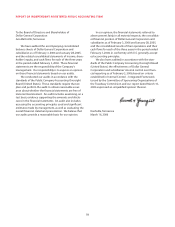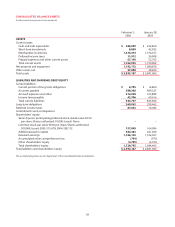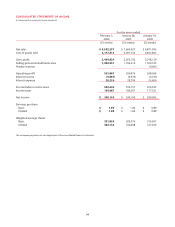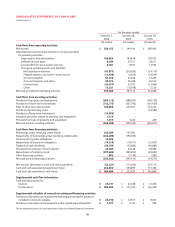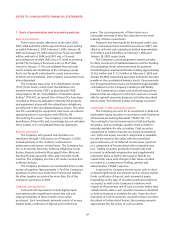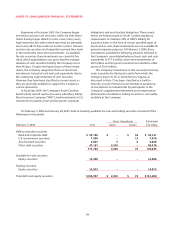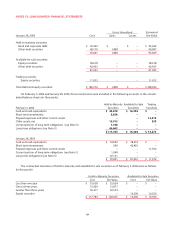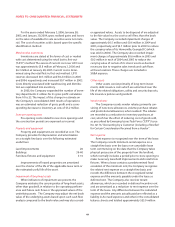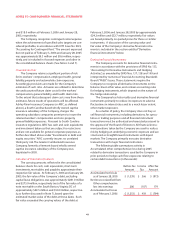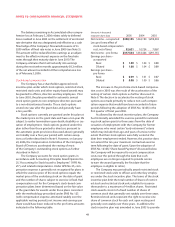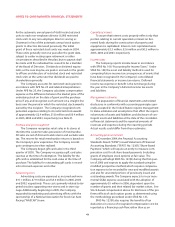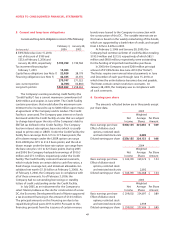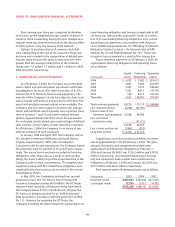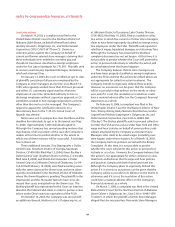Dollar General 2005 Annual Report Download - page 46
Download and view the complete annual report
Please find page 46 of the 2005 Dollar General annual report below. You can navigate through the pages in the report by either clicking on the pages listed below, or by using the keyword search tool below to find specific information within the annual report.
42
NOTES TO CONSOLIDATED FINANCIAL STATEMENTS
The balance remaining in Accumulated other compre-
hensive loss at February 3, 2006 relates solely to deferred
losses realized in June 2000 on the settlement of an interest
rate derivative that was designated and effective as a cash
flow hedge of the Company’s forecasted issuance of its
$200 million of fixed rate notes in June 2000 (see Note 5).
This amount will be reclassified into earnings as an adjust-
ment to the effective interest expense on the fixed rate
notes through their maturity date in June 2010.The
Company estimates that it will reclassify into earnings
during the next twelve months approximately $0.2 million
of the net amount recorded in Other comprehensive loss
as of February 3, 2006.
Stock-based compensation
The Company has a shareholder-approved stock
incentive plan under which stock options, restricted stock,
restricted stock units and other equity-based awards may
be granted to officers, directors and key employees. Prior
to June 2003, the plan provided for automatic annual
stock option grants to non-employee directors pursuant
to a non-discretionary formula. Those stock options
vested one year after the grant date and generally have
a ten-year life.
Stock options currently are granted under this plan at
the market price on the grant date and have a ten-year life
subject to earlier termination upon death, disability or ces-
sation of employment. Stock options granted under this
plan (other than those granted to directors pursuant to
the automatic grant provisions discussed above) generally
vest ratably over a four-year period, with certain excep-
tions as further described in Note 9. However, on January
24, 2006, the Compensation Committee of the Company’s
Board of Directors accelerated the vesting of most
of the Company’s outstanding stock options as further
described in Note 9.
The Company accounts for stock option grants in
accordance with Accounting Principles Board Opinion No.
25,“Accounting for Stock Issued to Employees”(“APB No.
25”), and related interpretations. Under APB No. 25, com-
pensation expense is generally not recognized for plans in
which the exercise price of the stock options equals the
market price of the underlying stock on the date of grant
and the number of shares subject to exercise is fixed. Had
compensation cost for the Company’s stock-based com-
pensation plans been determined based on the fair value
at the grant date for awards under these plans consistent
with the methodology prescribed under SFAS No. 123
(with compensation expense amortized ratably over the
applicable vesting periods), net income and earnings per
share would have been reduced to the pro forma amounts
indicated in the following table.
(Amounts in thousands
except per share data) 2005 2004 2003
Net income – as reported $350,155 $344,190 $299,002
Less pro forma effect of
stock-based compensation
cost, net of taxes 32,621 10,724 7,867
Net income – pro forma $317,534 $333,466 $291,135
Earnings per share –
as reported
Basic $ 1.09 $ 1.04 $ 0.89
Diluted $ 1.08 $ 1.04 $ 0.89
Earnings per share –
pro forma
Basic $ 0.99 $ 1.01 $ 0.87
Diluted $ 0.98 $ 1.00 $ 0.86
The increase in the pro-forma stock-based compensa-
tion cost in 2005 was the result of the acceleration of the
vesting of certain stock options as further discussed in
Note 9.The decision to accelerate the vesting of stock
options was made primarily to reduce non-cash compen-
sation expense that would have been recorded in future
periods following the adoption of SFAS No. 123(R) in the
first quarter of fiscal year 2006.
As allowed by the stock incentive plans, the Company
has historically extended the exercise period for outstand-
ing stock option grants to three years from the date of
cessation of employment with the Company for former
employees who meet certain “early retirement” criteria
which may include their age and years of service, to the
extent that their stock options were fully vested at the
date their employment ended. However, this practice does
not extend the ten-year maximum contractual exercise
term following the date of grant. Upon the adoption of
SFAS No. 123(R),“Share-Based Payment” discussed below,
the Company will be required to record compensation
costs over the period through the date that such
employees are no longer required to provide service
to earn the award (generally, the first date that the
employee is eligible to retire).
The Company may periodically award restricted stock
or restricted stock units to officers and other key employ-
ees under the stock incentive plan. The terms of the stock
incentive plan limit the total number of shares of restrict-
ed stock and restricted stock units eligible for issuance
thereunder to a maximum of 4 million shares. Restricted
stock awards consist of a fixed number of shares of
common stock that generally vest ratably over three years.
Restricted stock units represent the right to receive one
share of common stock for each unit upon vesting and
generally vest ratably over three years. In addition, the
stock incentive plan was amended in June 2003 to provide


